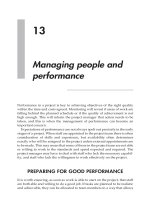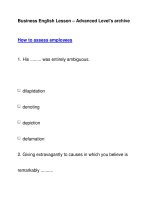Managing employees
Bạn đang xem bản rút gọn của tài liệu. Xem và tải ngay bản đầy đủ của tài liệu tại đây (117.13 KB, 19 trang )
Chapter 13: Managing Employees
Overview
The eye of the master will do more work than both his hands.
Proverb
[1]
Just because you pay an employee it doesn’t mean you have his loyalty. Rational
employees will always put their own interests ahead of your firm’s needs. Consequently,
salaries should not be seen as a way of gaining a worker’s allegiance; rather, they
should be viewed as a mechanism to alter an employee’s incentives to align his interests
with yours.
The great economist Adam Smith described how an invisible hand causes selfish
capitalists to act as if they were altruistic. A capitalist produces products not to satisfy
your needs, but to make money for himself. Manufacturers can only prosper, however,
by making products that consumers want. Consequently, the invisible hand of capitalism
causes business owners to care about their customer’s needs. The invisible hand of
capitalism, however, does not automatically make your employees care about you. It’s
your job as an employer to create a visible salary structure that forces employees to
adopt your concerns. No salary structure works perfectly, however.
[1]
Browning (1989), 417.
Attorney Fee Structures
Your company’s lawyers, like all employees, will do their job based on how you pay them.
Attorneys usually get paid by one of two methods:
They are paid by the hour.
They receive contingency fees, which are a percentage of any amount that
you win at trial.
If attorneys are paid by the hour, then they have an incentive to work too much, because
the more they work, the more you pay. When you pay by the hour, your attorneys have
the incentive to spend time considering every single legal subissue. This means,
however, that you should be most afraid of suing a company whose lawyers are paid by
the hour.
Attorneys paid by contingency fees have an incentive to work too little. Success for a
contingency fee lawyer comes from putting a small amount of time into many cases to
get as many contingency fees as possible.
Neither paying attorneys by the hour nor paying with contingency fees provides for ideal
incentives. When picking a fee structure, however, you must decide which would do you
the least harm. Perhaps you want to win at all costs, so you would want to pay by the
hour. Or, say, you fear attorneys padding their bill; then you should go with contingency
fees.
Doctors and HMOs
Like attorneys, doctors don't always have appropriate incentives to serve your interests.
Imagine that you are considering undergoing an expensive operation. You're not certain
if the operation will improve your health, so you consult your doctor for advice. First,
assume that the doctor who would perform the operation is an independent service
provider who gets paid based on how much he works. Getting the operation would
increase your doctor's salary, and so he has an economic incentive to advise you to get
the procedure.
Now, imagine that your doctor works for an HMO. You pay the HMO a flat fee, and the
HMO takes care of all your medical needs at no additional cost. Obviously, the HMO
would like to minimize these costs. Many HMOs, understandably, provide economic
incentives for their member doctors to keep expenses down, so your HMO doctor would
probably have some interest in recommending that you forgo the operation.
Independent doctors and HMOs also have different incentives with regard to preventive
care. It's usually much cheaper to stop a medical problem from occurring than it is to fix
a medical condition once it manifests itself. An HMO, therefore, has a massive incentive
to encourage its patients to take preventive care. HMOs should also want their patients
to live healthy lifestyles. Selfish, profit-hungry HMOs should desperately try to convince
their patients to exercise, eat right, and not smoke, for the less medical care you need,
the greater your HMO's profits.
Independent doctors, by contrast, are actually better off when their patients become
sicker, so they have negative economic incentives to give their patients lifestyle advice.
Taxes and Incentives to Work
Combating worker laziness often provides the paramount challenge for employers.
Economists have long understood that government taxes reduce individuals’ incentives
to work. Understanding how taxes affect effort will help you motivate employees.
Consider a game where you must decide how much to work. The more you work, the
more money you get. Unfortunately, for every extra hour you work, you actually have to
work one more hour. For mortal man, time is the most precious commodity. When we
work, we trade time for money, and the more money we earn per hour, the more most of
us are willing to work.
When the government taxes you, it reduces the benefit you get from working. If you must
pay, for example, 40 percent of your earnings in taxes, then for every extra dollar you
make, you really get to keep only 60 cents. This is one of the reasons why high taxes
slow economic growth, because they reduce incentives to work.
For example, assume that a college professor has the opportunity to teach a summer
class for $10,000. The professor would be willing to do it for only $8,000, but if he does
teach the course, he will net only $6,000 after paying taxes. Consequently, the professor
doesn’t teach the course, choosing summer leisure over high-taxed employment.
Tenant Farmers
Companies often tax their employees. For example, imagine that you rent land to a
farmer. You are considering three ways of extracting money from your worker:
1. You pay the farmer a fixed amount to work for you, but you keep all of
the crops he grows.
2. The farmer gives you a percentage of everything he grows.
3. The farmer pays you a fixed fee, but he keeps everything that he grows.
The farmer has the least incentive to work when paid a fixed fee. Under the first scheme,
the farmer gets paid the same amount regardless of his effort, so it’s in his self-interest to
work as little as possible. Taking a percentage of what the farmer grows it the equivalent
of taxing him. Under the second plan the farmer still has some incentive to work, but this
incentive is greatly reduced by your implicit tax. The farmer has the greatest incentive to
work if he must pay you a fixed fee. Under this scheme, if the farmer works a little harder,
he captures all of the benefits of his efforts.
Imagine that the farmer could work an extra hour and produce $30 more in crops. Under
plan (1) he would get none of this extra money, under plan (2) he would get some of it,
while under plan (3) he would get the full $30.
It might therefore seem then that you should always use plan (3) and have the farmer
pay you a flat fee. The problem with the third plan, however, is that it puts all the risk of
crop failure on the farmer. If he has a bad year, the farmer absorbs all of the losses.
Since most workers dislike risk, workers usually accept risk only if they are compensated
for assuming it. The farmer will agree to the third plan, therefore, only if he gets a high
average income. Under plan (3) the farmer must expect to make a lot of money in good
years to be compensated for a low income in bad years.
This tradeoff between risk and work always exists for employers. To motivate employees
to work, you usually need to make their salary dependent on how well they perform.
Employees, though, usually dislike risk and prefer steady, consistent paychecks. Firms
face a difficult choice. If a firm forces its workers to take on high risk, the workers will be
motivated to work, but will dislike this risk. If the firm pays employees a constant amount,
the workers will be happy with their safe jobs but may have little incentive to work hard.
The following game illustrates this employers’ dilemma.
Assume that a salesman can either (a) work hard or (b) slack. The employer can’t
observe the salesman’s efforts. The salesman will either do well or poorly. If the
salesman slacks off, he will always do poorly. If, however, the salesman works hard, he
will do poorly half of the time and do well the other half.
Table 8
Work Hard Slack Off
Low Sales 50% of the time 100% of the time
High Sales 50% of the time 0% of the time
How should the firm pay the salesman? If it always pays the salesman the same amount,
the salesman obviously has an incentive to slack off. If, however, the salesman’s salary
is based on his outcome, then he will be forced to take on a lot of risk, for even if he
works hard, he still might have a bad year. If you make employees take on too much risk,
they will demand greater salaries or will seek safer jobs.
The one way around the risk/motivating tradeoff is for employers to carefully monitor
efforts, not outcomes. In the previous game, you could achieve an ideal result if you paid
the salesman based on how hard he worked, not his total sales. An employee willing to
work hard would then face no risk. Unfortunately, determining effort is always subjective
and much more challenging than monitoring outcomes. There is consequently no
always-right solution to the risk/motivation problem; rather, each company must accept
that any pay structure will cause some inefficiency and seek to determine which
inefficiencies cause the least harm.
The tradeoffs between risk and reward are also an important topic in finance; this book
further explores them in Chapter 16, The Stock Market.
Outside Contracts
We can apply our risk/reward structure to outside contracts. Imagine that your company
hires another firm to construct a building. You can adopt one of three contracts, as noted
below.
[2]
1. You pay the builder a fixed amount.
2. You pay him a fixed amount plus a percentage of any cost overruns.
3. You pay the total cost of construction.
The contractor obviously has the greatest incentive to minimize cost in the first contract.
The first contract, also, puts the most risk on the contractor, so he would probably
demand the higher fee under this arrangement.
[2]
See McMillan (1992), 95.









